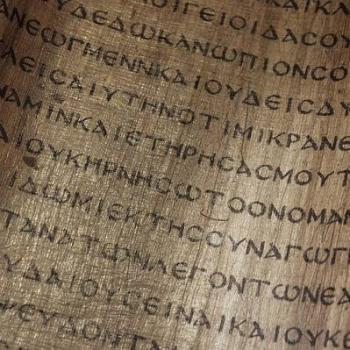THE QUESTIONS:
Why are there so many Bible translations in English on the market? Should there be?
THE RELIGION GUY’S ANSWER:
The Evangelical Textual Criticism blog is an international forum where conservative Protestant experts chew over what’s stirring with ancient manuscripts and translations of the Bible. See https://evangelicaltextualcriticism.blogspot.com It’s esoteric stuff for the most part, but some items carry broad interest.
This week’s top posting, worth pondering by everybody, begins with this biblical bang: “It’s time for someone to stand athwart American Christianity and yell ‘STOP’.” The piece pleads with publishers and scholars to no longer turn out ever more new Bible translations because this “rising tide sinks all boats,” causing confusion that undermines trust in the Scriptures. The writer is Mark Ward, academic editor of Lexham Press, which publishes Bible study materials that include its own Lexham English Bible (LEB) translation, with textual detail for “specialized study,” not everyday use.
The article takes direct aim at the newly announced Legacy Standard Bible (LSB) that is being translated by an influential California pastor Ward greatly respects, John MacArthur, and colleagues at The Master’s University and Seminary. MacArthur has long favored the very literal (and thus rather wooden) New American Standard Bible, issued in 1971 and now available in a 1995 update. Another NASB update is due within a year but the pubisher will keep the 1995 rendition in print also. Ward says MacArthur’s Bible is in the same tradition, so soon we’ll have three variants of one Bible on the market.
He is not pleased about that. And he “simply cannot bear” MacArthur’s “marketing slogan” that his Bible will be “absolutely accurate.” Legitimate views on what that means with a particular passage will never agree, he says, and “there is no possibility – none” that the new Bible is more accurate than the major translations already available.
This debate deals with only the actual text of the Bible translated into English, not the host of study editions that add explanatory footnotes, sidebars, maps, charts, and articles, some pitched to particular audiences such as women, youth, or recovery groups. Those variants are one answer to the “why” question above. Another is that Protestants and Catholics have different Bibles because their Old Testament has a slightly different list of books. And — let’s be honest — there’s money to be made from the novelty of a new translation, especially if it catches on.
Instead of those editions, Ward is talking about “centrist” translations designed for wide use by churches and individuals. These range on a spectrum from literal or word-for-word “formal equivalence” as found in the NASB over to thought-for-thought “functional equivalence” rendered in English as it is in actual everyday use today.
The market also offers technical editions like his own company’s LEB, or loose paraphrases like “The Message” that he thinks can be useful “tools,” or those aimed at helping people with limited facility in English. He sees value in pondering the recent “single-scholar” translations of the Old Testament by Robert Alter (published by Norton) and John Goldingay (InterVarsity), and of the New Testament by David Bentley Hart (Yale) and N.T. Wright (HarperOne).
Time was that virtually all Protestants of whatever denominations and leanings united in using Britain’s King James Version of 1611. Its wordings were “common coin,” widely quoted and memorized. Ward thinks “we lost something” when that dominance eroded, but it’s unlikely any one Bible will achieve such a status again. Under the circumstances, he thinks it’s good for serious readers to consult several standard renditions.
But there’s a limit.
The article itself demonstrates today’s alphabet soup. In addition to the NASB95, and forthcoming new NASB and LSB, we have the King James plus New KJV and KJ21. Ward, by the way, chides the hardline “King James only” faction that claims this is the one and only Bible for true believers. Ward also mentions the BEB, CEV, CSB, ESV, GW, ISV, NET, NLT, WEB, and the NIV and NIVI and NirV. He scorns by name several products he deems “misguided, irresponsible, or even wacky,.” That above list is just for starters. You can search the texts of 25 English Bibles on www.biblehub.com and fully 59 on www.biblegateway.com.
Dreaming on, Ward would like to see “a non-proliferation treaty” among Bible publishers, pledging to put out revised editions every 35 to 50 years that make necessary adjustments on this word or that, not entirely new Bibles. Otherwise, we foster “the public perception that the Word of God is our creation, rather than we its.”
Since he writes for fellow evangelicals, Ward ignores Catholicism’s New American Bible (NAB, 1970, revised 2010) and these two “mainline” Protestant favorites available in Catholic editions. The Guy recommends for journalistic purposes the Revised Standard Version (RSV, 1952, second edition 1971) because it has a far richer manuscript basis than the King James but retains much of the King’s familiar phrasing. The New Revised Standard Version (NRSV, 1989) is preferred for those who want more inclusive language.












